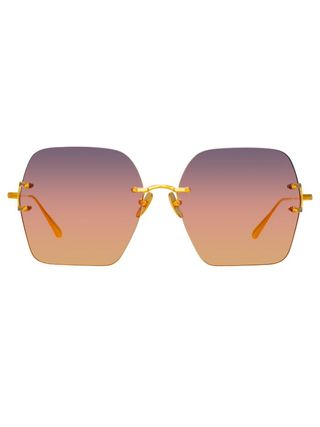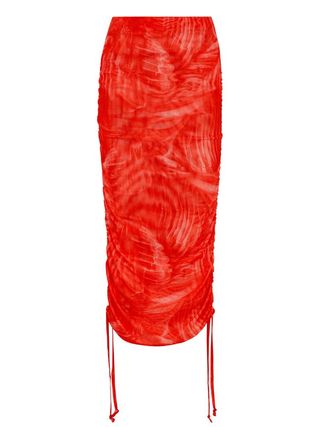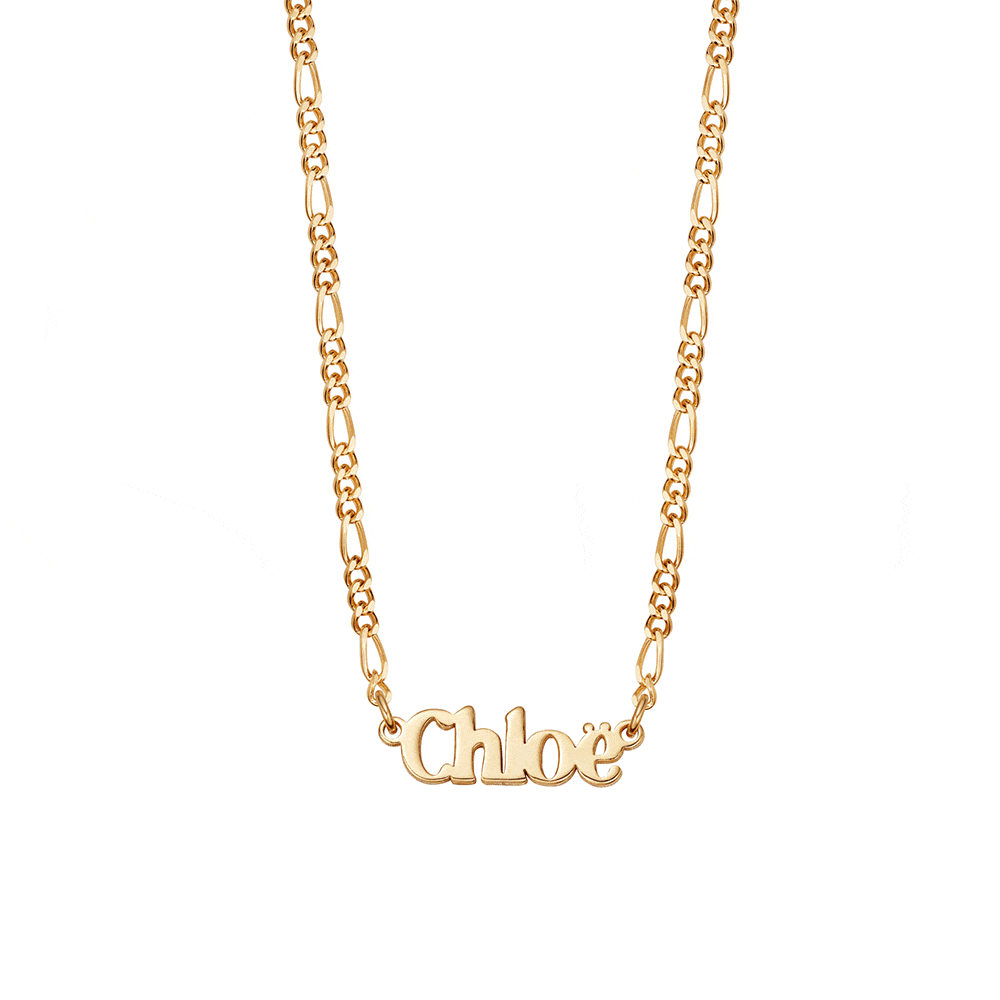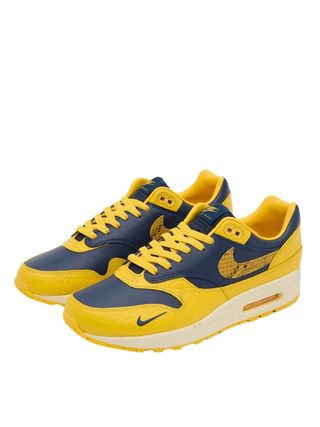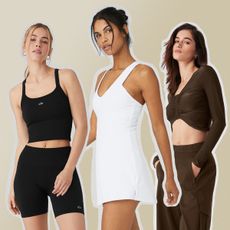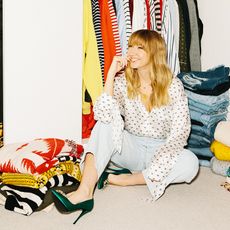Best Wardrobes in Britain: Alizé Demange


In her own words, Alizé Demange is a force that "cannot be stopped". In the few hours we spend rifling through the celebrity stylist and consultant's wardrobe, we talk about a variety of topics, film TikToks, play music and do a lap of her neighbourhood, all at breakneck speed. It stands to reason that someone with a job (and a personality) like Demange's would move at 100 miles an hour, as one day she might be styling a Premier League football team, and the next she's hosting her Youtube show Add to Wishlist. But what is clear is that at the heart of whatever project Demange turns her hand to, it's her enthusiasm for fashion that is the driving force at the centre of it.
"My mum never dressed me or told me what I had to wear; I always styled myself," she muses, as we ask her to choose the five items she can't live without. Five items become six, and eventually, seven and eight, as it's impossible to limit Demange once she starts pulling together a look, taking pieces from merchandising rails rather than a typical wardrobe (a conscious decision on her part, so she can see all of her collection at once).
From appearing in a Grazia street style shoot in 2014 to styling musicians, campaigns and international cover shoots, Demange has built an impressive career that now includes hosting, but how does she feel about stepping into her new role as interviewer? "People are way more receptive to being on camera since TikTok; they know the formula and the format, and they're always camera-ready. What used to be local trends now become worldwide thanks to the internet building a global community," she notes, although with over 22,000 followers on Instagram and 95,000 likes on TikTok, she's a prime example of her own theory, complete with the rapt audience.
So, should you be wondering what a stylist's wardrobe really looks like, where better to start than a collection that houses everything from Prada bags to John Lewis school uniform kilts, of which Demange says, "Not only are they the perfect fit, but you don't have to iron them." Keep scrolling to see how Demange uses her vibrant and eclectic wardrobe to piece together Y2K-inspired looks, and to see why I'm convinced she has one of the best wardrobes (make that rails) in Britain.
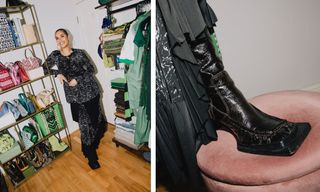
So, you’re a born and bred Londoner. How did growing up in the capital influence your style?
I think it has in a lot of ways. I was born in 1991 and grew up in the early 2000s, and a lot of what we're seeing repeated now are the things that influenced my style growing up. I'm probably such a big trainer fan because I couldn't afford the trainers I really wanted when I was younger. So, a lot of the things that I was in awe of growing up as a teenager, I can now get for myself. When we were growing up there was always this expression that "West girls dress the best." West London just has its own unique style. North didn't get any love. East and South? Maybe.
When I was younger, my mum would always take me to Portobello Market every weekend; she's more of a thrifty person and loves buying little things. She can go to charity shops and grab a bargain. And my granny was super into clothes, and really, really fashionable. So I think I definitely got a lot of inspiration from my family and being in West London, with direct access to central, Kensington High Street and all these cool places to shop, and you have a lot more time to create the style that you want when you're a kid.
At college and uni, we didn't have fast fashion, so you couldn't just order something to come tomorrow. That meant I was remixing a lot of stuff I already had. I'd cut things up, make tops out of tights—I didn't have money to keep buying things. And when we'd go to raves every Thursday and Friday, there had to be a new outfit every week because we'd get our pictures taken! So every Thursday and Friday, I would make a new 'fit from scratch. That was a really innovative time for me.

What is your earliest fashion memory?
Definitely spending time with my nan on the weekends. My favourite pastime was going through her wardrobe and trying everything on. She had loads of furs and feathered stuff and all this makeup. My mum wasn't really girly so it was my nan who had all the makeup, the perfume, the heels—I just had to wear her heels all the time—and she would let me do whatever I wanted. That really influenced me to want to be a fashion stylist, because it was the first time I thought that clothes were so cool and could make you feel good.
If we looked through your wardrobe on any given day, what could we expect to find?
A lot of tracksuits. And now it's winter, I'm really in my tracksuit bag. They're my most comfortable thing. I think I just like sets; I'm a set girl. I love co-ords of every kind, so you're definitely going to find a co-ord of every vibe. Mentally, it's an easy, instant outfit to put together. I also like the coordination of it. It's neat.

What clothing brands best represent your style? And how has that changed since you were younger?
I don't think my style has changed since I was younger. I've always kind of had these different facets; whether it's streetwear or vintage or loungewear. The only thing I think I'm more comfortable wearing now is heels. As I've gotten older, it doesn't feel weird for me to wear them, but I used to feel like I was always playing dress-up if I wore heels, especially in a day setting. Now I love wearing heeled boots and it's not weird at all. I really like brands like Ganni; I think they're more representative of the age that I'm at now. I look for a combination of comfort and coolness that can still be chill but with an elevated vibe. I really, really love Marques Almeida too—all of the distressed denim, the wide fit and the baggy vibe. But then I'm no stranger to bodycon either, it can be anything any day.
You work with some of Britain's best artists, presenters and personalities. What's your proudest styling moment and how did it make you feel about the industry as a whole?
I did an editorial for Vogue Arabia with the Muslim Sisterhood, and I think that is actually my proudest moment. It was an eight-page spread and they asked me to do an editorial shoot for them. And I think, from what they've said, that I have a good perspective on modest style as well. My mum was more of a modest dresser and I think there are a lot of ways you can style it up. I thought it ended up being an amazing piece and a milestone, especially for them [the Sisterhood], and that was a big deal for me because I'd never been in Vogue before. It was cool.
I think that there's a lot to lean into with the idea of what it's like to dress a woman when you're de-centering men and the male gaze. There was a time in my life when I just liked everything I was wearing and it wasn't about femininity, and then there was another time in my life when I had naturally started putting on weight and I felt like I had to play into my femininity in order to feel "beautiful". But now I feel completely differently because I think it was more about the fact that I didn't feel attractive to men. Or to myself, maybe. Now, I don't want to focus on that. I just want to wear what I like wearing, and I'm in a much more fun, happy place because of that. I'm also happy with my body right now. Everyone has a different view of what desirability and attractiveness are, and this is coming from someone who's been a size six and a size 16.
Ultimately, my job is to make someone look and feel amazing in an outfit. That's the actual concept of my job. And this doesn't go for all brands by the way, because some people are doing their jobs fantastically, and they have full size ranges of stock, but some don't. Everyone should be diversifying their catwalks and their sample sets. There's nothing worse than going into a fitting and you don't fit into anything, because from the talent's perspective, it's like it's [their] fault or something. But obviously, we know how sizing is different for every brand—that's another fucking issue! So I always say to clients, "Don't worry about what the number is on the label, as long as it fits you and it looks amazing, that's all that matters."
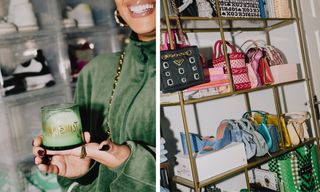
You made the move from styling and consulting to hosting your show Add to Wishlist on Youtube. What's it like to be on the other side of the camera and where do you feel most comfortable?
You know what? I really like it. I get to work with my friends so it's never uncomfortable; it just feels like we do a lot of chatting shit, to be honest! I like commenting on trends and discussing what's going on in fashion, and voicing my own opinion on it as well as hearing what other people have to say and hearing about their journeys. I've always had a lot of respect for people who start fashion brands from scratch for example, because it's not easy.
It's not an easy feat to be able to pour out your creativity into something and then try to sell it to other people whilst juggling seven different jobs in one role. As a stylist, you're constantly partnering with and supporting each other and smaller designers, and I wanted Add to Wishlist to spotlight people who were coming up or doing cool stuff. Talking about stuff that we liked or didn't like just came off the back of it. I think people have an interest in my Instagram, what I wear on a daily basis and what I pick for my clients, so it kind of evolved from there.
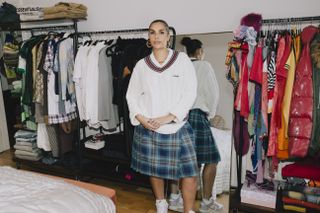
Hosting the show puts women of colour at the forefront. How important was it for you to create your own show that allows you to set the agenda and tone of voice?
It's so within my nature. I've always found it really difficult to get into corporate spaces, and even when I was younger I couldn't get a really good internship. I don't know whether it was me or them, but it felt super difficult, so I ended up doing a lot of my own things. I made my own zines, worked with a lot of blogs, worked with our own artists, and now, working in my community and within my culture has led to bigger things down the line. I've never been afraid to do my own thing; I know that a lot of rules and regulations come with the mainstream route, and I want the challenge of being able to build my own community. I felt like there was a gap in the market for this, and I believe it will grow. You'd be surprised how many people will be supportive of what you do when you do something authentically and they connect with it. Fear holds people back, and I'm a big believer in jumping into what is meant for you and not being afraid of where the journey's taking you.
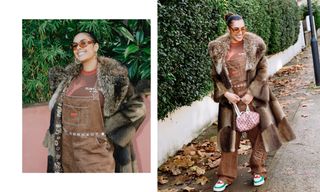
What does a typical day look like for you?
Honestly, I have no routine. My typical day changes every day and I tend to do my calendar the night before. The thing about being freelance is that no day is ever the same. There are some days that I'm not really doing anything, but that's not right now! I think it works for my brain because actually, I thrive in those kinds of situations. I once had an internship at a sports brand and I used to fall asleep every day at the desk because it was so boring. I just couldn't do the same thing every single day, it felt like really a weird concept.
If you could wear one outfit for the rest of your life, what would it be?
To be honest, it's easy. Definitely a tracksuit or a set!
Are there any pieces in your wardrobe that are very sentimental to you, and why?
Yeah, I have some of my granny's stuff. I still have a skirt that she got when she was, like, 20, so it would have been from when my dad was born. I've kept it all this time, and I remember my friend going through my office and she was like, "What? You don't wear this!" but I won't ever give that up. She was tiny so I don't wear it, but I don't want to get rid of it. I think it's also a testament to time that these pieces are 50 years old and still intact.
A lot of my jewellery is also sentimental. I've invested a lot of money into getting my own personalised pieces. That's something I learned from my nan as well. She had loads of jewellery and would give me things, and there's definitely something in investing in stuff that is never going to disintegrate or lose value. It's so beautiful to me and they're all precious, it just feels so personal. No one else is going to have it. It's just for me.
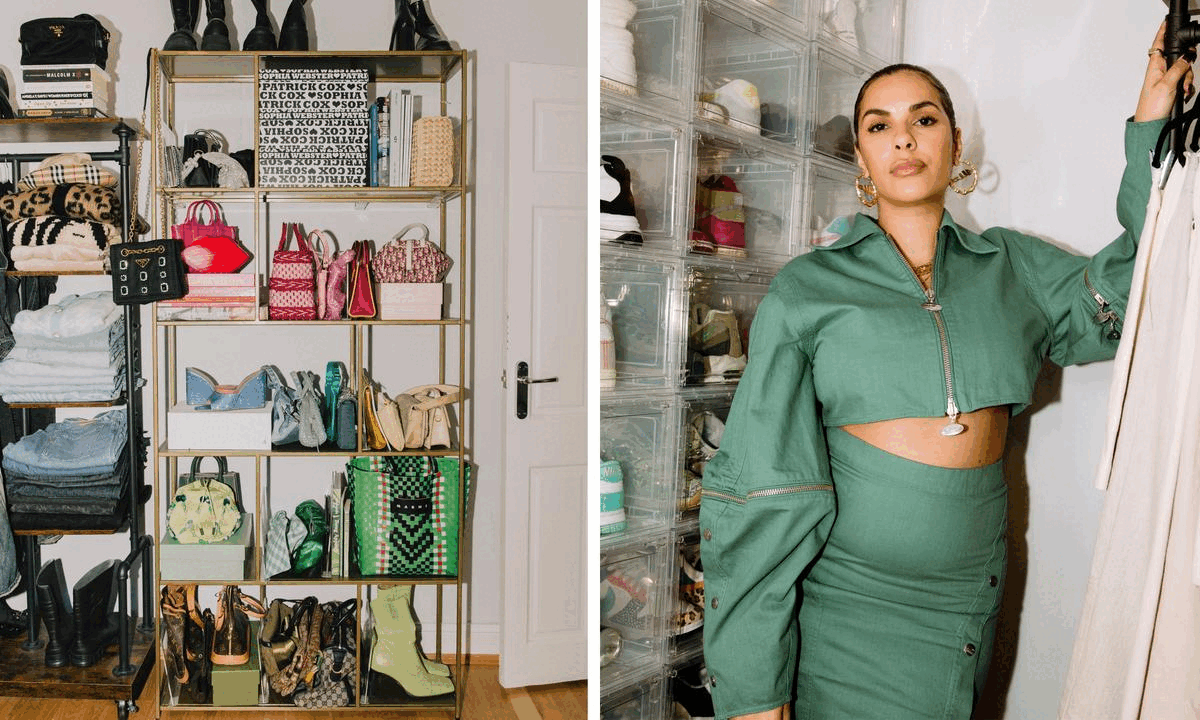
Your grandma must be up there with your style icons. Who else makes the list?
Someone I really want to dress like, low-key, is Simone Rocha. Pretty, romantic, but kind of tough. The Chopova Lowena vibe is another one I love; there's something punkish to the look and deep down, I really, really like that. When I was growing up, Vivienne Westwood was definitely one of my big idols. I love corsetry and the historical period pieces and having that twisted into asymmetric shapes, adding tartan and check—I love all of that. There was a time I wasn't dressing nicely at all because I was working so much that I just had a rotation of five Nike tracksuits that I could wear every day for ease. I’m okay with not always being the best dressed in the room, but I can appreciate when something looks good.
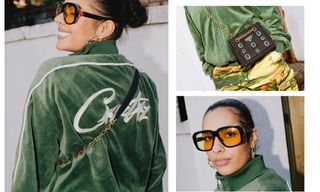
You set up styling education platform AD Creative to help young creatives get into fashion, and you recently hosted WePresent’s documentary Drop School, which followed an aspiring designer's journey into fashion. How do you see your role as a mentor and someone paving the way for the next generation of creatives?
Going back to what I mentioned earlier, I felt like I didn't have a very good way into the industry, and if I had had more of a direct mentorship or help like that, it wouldn't have taken me, like, 10 years to do what I was doing. It wouldn't have taken me seven years to start making any money, and I ended up meandering because I didn't have that entry point. Once I made it on my own and started having my own assistants, I saw how quickly they were able to start working and finding their own clients, and I just wanted to share that in an accessible way.
I've always had people messaging me and asking how I got into it, and it does feel like styling is a kind of gate-kept world. Styling can be laborious and it's not well paid until you get to a certain level. Whether you do other stuff or you've got a good client base, however you build your business, there are many, many different ways of doing it. I come from a working-class background so for me, it's important to mentor because I don't know any other way, and even I had loads of privileges. It's hard to live in London and do this job and be freelance and pay the rent.
What’s the best piece of career advice you’ve ever been given?
You have to follow your gut. It's such a cliché and sounds so corny, but you really do have to follow your gut. A lot of people end up working in a job that they don't want to do. And it takes commitment; really committing to the idea that you're not going to have any time left for yourself if you're going to pursue having your own business. Society wants you to go and work and work for the man. So you're going to have to push hard if you want to be able to live freely.
At the same time, if you think you're being overworked, you probably are. If I work 15 hours for my own business, that's my problem, but don't glamorise the "Girl Boss". If that's not for you and you want to live a soft life, that's okay! Not everyone has to have a side hustle. If anything, it's probably just glorified capitalism, because why do we have to work so hard to be able to buy? It's actually okay to live normally within your means—we're meant to work to live, not live to work.
What’s next for you?
Keep watching out for Add to Wishlist, because I definitely want that to be my main focus right now. I've worked on some great things this year so far and I'm so pleased that I've done Jorja [Smith]'s Falling Or Flying tour campaign, that I haven't got into my 2024 bag yet! I've had such an amazing 2023 in terms of hitting all those goals that there isn't much I feel like I haven't done. Maybe a collab on a collection, or making something. I want to have my own tracksuit!
Thank you for having us, Alizé!
SHOP ALIZÉ DEMANGE'S STYLE:
Next Up: Best Wardrobes in Britain: Nina Hopkins

Remy Farrell is a London-based shopping editor with nearly 10 years of editorial experience covering fashion, beauty and lifestyle. After graduating with a journalism degree and working on the editorial and fashion teams for titles such as Grazia, Elle, Cosmopolitan and British Vogue, she moved into the luxury e-commerce sector, working as fashion assistant at TheOutnet.com styling for the social media channels and helping to develop the collections for the in-house brand Iris & Ink. After expanding an assisting and styling portfolio that includes shooting talent such as Gigi Hadid, Victoria Beckham and Miquita Oliver, she also branched out into beauty, creating tried-and-tested reviews and diverse beauty content.In her role as shopping editor at Who What Wear, Remy is interested in discovering new and exciting brands to share with the Who What Wear readership and particularly loves uncovering hidden gems at affordable prices to make shopping accessible to everyone.Born and raised in Sheffield, Yorkshire, Remy moved to London in 2014 and lives in the Docklands with her partner and pug Billie.


